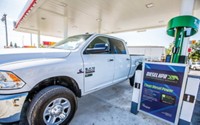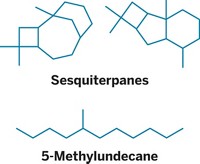Advertisement
Grab your lab coat. Let's get started
Welcome!
Welcome!
Create an account below to get 6 C&EN articles per month, receive newsletters and more - all free.
It seems this is your first time logging in online. Please enter the following information to continue.
As an ACS member you automatically get access to this site. All we need is few more details to create your reading experience.
Not you? Sign in with a different account.
Not you? Sign in with a different account.
ERROR 1
ERROR 1
ERROR 2
ERROR 2
ERROR 2
ERROR 2
ERROR 2
Password and Confirm password must match.
If you have an ACS member number, please enter it here so we can link this account to your membership. (optional)
ERROR 2
ACS values your privacy. By submitting your information, you are gaining access to C&EN and subscribing to our weekly newsletter. We use the information you provide to make your reading experience better, and we will never sell your data to third party members.
Environment
Chemistry Fuels Racing
ACS Meeting News: Science and engineering provide a spark to help make race cars run their best
by Bethany Halford
September 30, 2013
| A version of this story appeared in
Volume 91, Issue 39

It’s tough to pin down the precise aspect of motorsports that most attracts its legions of loyal fans. The need for speed. Perhaps the noise or the smell of burning rubber. Maybe it’s the thrill of a crash—waiting to see whether drivers walk away unscathed.
But from a science and engineering perspective, motorsports are simply about turning the chemical energy of a high-performance fuel into mechanical energy where the wheels meet the track.
Although motorsports are largely the domain of automotive engineers and heavy-footed drivers, chemists and chemical engineers do have a vital role to play. At the American Chemical Society national meeting in Indianapolis early this month, several speakers took to the stage to talk about the chemistry that fuels motorsports in a symposium called “The Chemistry of Racing,” which related to the meeting’s theme of “Chemistry in Motion.”
“Racing fuels bear little resemblance to street-legal fuels,” said Indresh Mathur, director of R&D for Houston-based Haltermann Solutions, a company that creates custom fuels for race cars as well as SpaceX rockets. The gas we put in our passenger cars, Mathur said, is designed to maximize efficiency and lower emissions, all while meeting strict government guidelines.

Racing fuels, on the other hand, are tailored to the particular car’s engine. They are designed to make the race car go as fast as possible without destroying the engine in the process. Racing fuels are not designed for good gas mileage, Mathur said. “They’re designed to give you speed and a quick burn.” For example, he noted that the fuel efficiency for cars that run in the Indianapolis 500 is roughly 3 mpg.
Racing fuels aren’t subject to Environmental Protection Agency guidelines that govern what’s in everyday gasoline. Rather, the guidelines for racing fuels are determined by different sanctioning bodies that govern individual racing series.
Formula 1 cars, for example, run on specially formulated gasoline. These are long, low, open-cockpit cars that are synonymous with Mario Andretti.
Mathur said that octane rating, essentially a measure of how much compression a fuel can take before it detonates in the engine cylinder, is the number one parameter when it comes to designing gasoline-based racing fuel. “The racing industry has been in constant pursuit of components to provide an octane boost,” he said. Toluene, for example, has a favorable octane rating, and as a result it has been a vital component of gasoline and is used in higher concentrations in racing fuels. “Toluene does burn slower so you have to balance it with other lighter components, otherwise the throttle response would be poor,” Mathur adds.
Of course, just because a chemical can give an engine a burst of power doesn’t mean it’s accepted practice to add it to the fuel tank. That’s where Timothy D. Ruppel comes in. As a senior field applications scientist for analytical instrument manufacturer PerkinElmer, part of Ruppel’s job is to test for substances racing teams might illegally add to the tank to give them an edge over their competitors—basically, he’s trying to catch cheaters in the act.
Ruppel has been in pursuit of scofflaws since 1987, and he’s worked with Formula 1, the Indy Racing League, and other racing organizations. The process is pretty simple, Ruppel told meeting attendees. For example, at the Indianapolis 500, he and his team will draw out fuel samples from the underground storage tank where all the cars get their fuel. They’ll also take samples from the fuel tanks of every car in the race, the storage carboys in each racing crew’s pit, and from the tanks of the top 12 finishers after the race. Those samples are then injected into a gas chromatograph to verify the composition of the fuel, similar to drug testing for athletes.
“The key thing you’re looking for is that the fuel in all the sampling locations matches the fuel that came out of the underground storage tank. That shows there was nothing added to give additional performance to the fuel,” Ruppel said.
And he has caught cheaters. Ruppel won’t name individuals or races. He estimates that in the 26 years he’s been analyzing racing fuels, irregularities have shown up about a dozen times. That’s pretty rare, he notes, considering he and his team run approximately 200 samples per race, which adds up to about 10,000 racing fuel samples analyzed during his career.
What has he found? Racing teams have tried to sneak ethylene oxide and nitrobenzene into fuels. A crew once tried using molecular sieves to take traces of water out of the fuel, thereby maximizing its power. A different team tried to get an extra burst of energy from propylene oxide, which it smuggled on board in the race car’s roll bar.
Ruppel said another team swapped the flame-fighting compounds in the car’s cockpit fire extinguisher for nitrous oxide. In case of fire, the extinguisher is designed to deliver suppressant chemicals directly into the cockpit with the press of a special red button. This team had rejiggered the extinguisher to send the illegal nitrous oxide directly to the engine. “Going down the straightaway, all you’d have to do is press that red button and BOOM, you’d get a burst of speed,” Ruppel said.
Once at a race, Ruppel found the same irregularity in the fuel tanks of nine different cars. It turned out that phthalate plasticizers from a rubber fuel bladder were leaching into the fuel, which wouldn’t have helped anybody in the race, he said. “If anything it could hurt them,” Ruppel added. “Nobody ever wanted to use that fuel bladder again.”
Over the years, Ruppel said, pit crews have told him they don’t add anything to their fuel because they know they’re being watched. But he’s also been asked what could be put into the fuel that his chemical analysis couldn’t detect. Ruppel’s answer: “There is nothing that you could put in there that would help the engine that I can’t see.”
Some folks tinker with what’s in the tank for nonnefarious reasons. Stuart R. Coles, an assistant professor of sustainable materials at the University of Warwick, in England, has been trying to make racing greener through the use of biofuels.
Coles and his colleagues’ first effort to that end was in 2007, when they made EcoOne, a racing car with a natural fiber composite body that ran on bioethanol. Coles said that while the car garnered a lot of attention, it also received a bit of ridicule, with some commenting that it looked like the kind of thing you’d put together from a kit in a shed.
So Coles and his coworkers decided they were going to make a truly green race car. After nine months of work, they had WorldFirst—a Formula 3 racing car that boasts a body crafted from renewable or recycled materials. The cars in Formula 3 racing are similar to but slightly less advanced than those in Formula 1. Drivers often participate in Formula 3 racing as a stepping stone to Formula 1. WorldFirst’s steering wheel was made from a polymer derived from carrots. The brake pads were made from cashew nut shells. Recycled carbon fiber went into the engine cover and other components. The only component that didn’t get a green makeover was the safety cell, the part of the body that houses passengers, Coles said, “because we wanted people to drive it.”
Coles also wanted the fuel that went into the tank to be environmentally friendly, so he designed the engine to run on biodiesel. “Bioethanol is ethanol derived from sugar or corn. But you can’t change the chemical structure of ethanol. It is what it is. In terms of actual research there really isn’t much you can do with it,” he said.
“Biodiesel, however, refers to a class of chemicals known as fatty acid methyl esters,” Coles explained. “There are a lot of things you can do with these molecules.”
For example, Coles said, different biodiesel sources will give fatty acid methyl esters of different chain lengths or different levels of saturation. By seeing how such variations affect engine performance, it’s possible to optimize the biodiesel’s properties.
In this way, Coles and coworkers set about to find the perfect biodiesel source for the WorldFirst race car. They tried a number of plant sources for biodiesel, such as soybean oil and rapeseed oil, as well as waste solids such as beef tallow and salmon fat.
“I would not recommend using waste salmon fat to make biodiesel, because it smells just as bad as you can imagine,” Coles said.
Ultimately, Coles settled on cocoa butter, which, he said, will not make your car smell of chocolate. “Cocoa butter performs better because it is very heavily saturated. It’s got all the good characteristics of fuel we want in terms of combustion. The downside is that it is a solid lump of material, so we had to mix it with rapeseed oil methyl esters.”
And the WorldFirst car was fast, Coles noted. His team took it to a Formula 3 racing event in England in 2009. The rules prevented them from actually racing the car—diesel cars weren’t allowed to participate—but WorldFirst ran qualifying laps and had the third-fastest speed in those heats, Coles said.
It’s the combination of chemistry and engineering that really delivers a racing car’s performance, Coles concluded. “The chemistry is quite simple, but having the knowledge of the chemistry and being able to apply it to the engineering to deliver the vehicle’s performance is a good example of multidisciplinary work.”





Join the conversation
Contact the reporter
Submit a Letter to the Editor for publication
Engage with us on Twitter